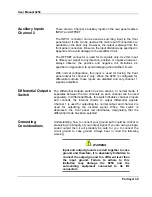
User Manual 9250
Portrayal 3-3
Repair and
Replacement
Repair and replacement of electrical and mechanical parts must be
accomplished with great care. Printed circuit boards can become
warped, cracked or burnt from excessive heat or mechanical stress.
The following repair techniques are suggested to avoid inadvertent
destruction or degradation of parts and assemblies:
1. Use a 60/40 solder and temperature-controlled 35 - 40 watt
pencil-type soldering iron on the circuit board. The tip of the
iron should be clean and properly tinned for best heat transfer
to the solder joint. A higher wattage soldering iron may sepa-
rate the circuit from the base material.
2. Keep the soldering iron in contact with the PC board for a
minimum time to avoid damage to the components or printed
conductors.
3. To de-solder components, use a commercial "solder sucker"
or a solder-removing SOLDER - WICK, size 3.
4. Always replace a component with an exact duplicate as speci-
fied in the parts list.
Performance
Checks
The performance of the 9250 should be checked to verify proper
operation of the instrument and should normally be used:
1. As a part of the incoming inspection of the instrument specifi-
cations;
2. As part of the troubleshooting procedure;
3. After any repair or adjustment before returning the instrument
to regular service.
Environmental
Conditions
Tests should be performed under laboratory conditions having an
ambient temperature of 25
°
C,
±
5
°
C and at relative humidity of less
than 80%. If the instrument has been subjected to conditions outside
these ranges, allow at least one additional hour for the instrument to
stabilize before beginning the adjustment procedure.












































